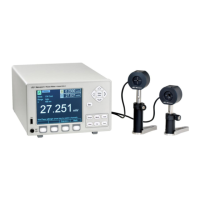68 Performing Basic Measurements
pulses. The meter will display the last pulse energy measured until a new
pulse arrives.
Accurate measurements can be made for pulse repetition rates up to 10 kHz,
depending on the limitation of the specific detector in use, of course.
5.7 Signal Integration Measurements (918D or 818P
Detectors)
This section describes the procedure for making a basic signal integration
measurement while properly removing the influence of ambient light and
other drift effects. The 1936/2936 Series begins and ends the signal
integration every second.
With a 918D or 818P Detector connected to the meter, turn the meter on. Set
the Mode to CW Continuous. Set the Range to Auto and press the Lambda
(λ) key to set the measurement wavelength to the desired value.
Cover or otherwise block the light source being measured, turn Zero on and
then set the Mode to CW Integrate. Immediately upon entering the
integration mode, the meter will begin to acquire and integrate data. The
display value may reflect the integration of noise due to ambient temperature
fluctuations (when using the 818P detectors) or light fluctuations (when using
the 918D detectors).
Uncover or trigger the source. The displayed value should now reflect the
detector signal integration value.
NOTE
This process assumes that ambient signals are not changing between the moments
when the user zeros the display and when the measurement is made.
5.8 Measuring Laser Pulse Energy with an 818P Thermopile
Detector (Single Shot)
This application makes use of the 1936/2936 Series’ CW Integrate mode (see
Section 5.7 above). When an optical pulse with energy E(λ) is incident on a
thermopile (818P Series), a voltage signal is generated at the detector input as
the heat pulse flows out to the cooling fins. The sum of a series of integrated
signals (each one second long) resulting from this heat pulse is a measure of
the optical pulse energy, see Figure 60.

